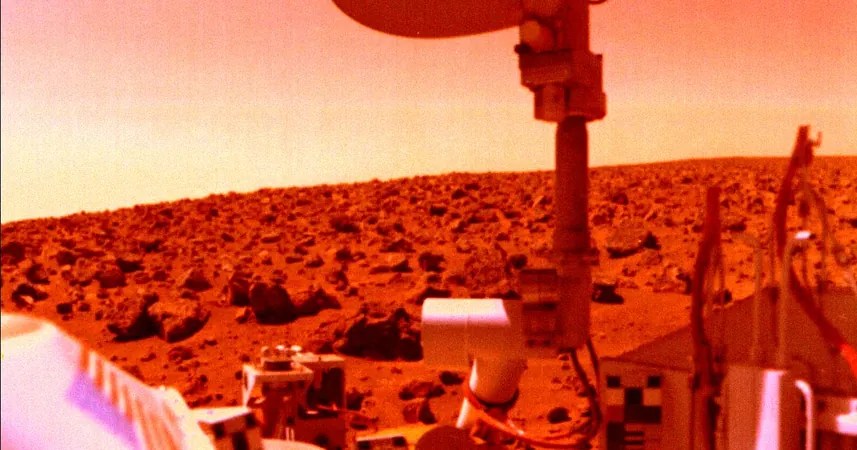
Could NASA's Viking Missions Have Obliterated Life on Mars? Shocking New Theory Revealed!
2024-11-16
Author: Ying
Astrobiologist Dirk Schulze-Makuch's Hypothesis
Astrobiologist Dirk Schulze-Makuch from the Technische Universität Berlin has put forward a provocative hypothesis that could change our understanding of life on Mars. He suggests that the Viking missions conducted by NASA in the 1970s may have inadvertently extinguished any potential Martian life forms during their key experiments.
The Viking Missions and Their Experiments
In 1976, NASA's Viking 1 and 2 spacecraft landed on the Martian surface, where they conducted groundbreaking experiments involving the mixing of water and nutrients with Martian soil samples. The prevailing assumption at the time was that life on Mars would operate similarly to life on Earth—and thus, would require liquid water to thrive.
Initial Findings and False Indicators
However, as reported by Space.com, the initial findings did seem to hint at the existence of life on Mars. Yet, after extensive analysis, scientists concluded that these positive readings were likely false indicators. Schulze-Makuch's theory takes this notion one step further, proposing that the Viking landers might not only have encountered Martian life but also inadvertently destroyed it by introducing too much water.
Life on Mars and Salt Deposits
He believes that any life forms that may have existed on Mars might have relied on salt deposits for survival, akin to the extremophiles found in Earth's most arid regions, like the Atacama Desert in Chile. These organisms can obtain moisture from salts that absorb water vapor from the atmosphere, a survival strategy that could potentially apply to the surface of Mars.
Insights from Nature
In a compelling commentary for the journal Nature, Schulze-Makuch stated, "In hyperarid environments, life can obtain water through salts that draw moisture from the atmosphere. If these inferences about organisms surviving in hyperarid Martian conditions are correct, then rather than 'follow the water,’ we should also follow hydrated and hygroscopic compounds—salts—as a way to locate microbial life."
Impacts of Water on Extremophiles
He analogized the situation to using table salt to create a brine where certain bacteria thrive, noting that sodium chloride appears abundant on Mars. "This means this idea could work," he explained.
The Atacama Desert Example
Drawing attention to a study that revealed torrential rain decimated 70 to 80 percent of bacteria in the Atacama Desert due to a sudden influx of water, Schulze-Makuch suggested that similar conditions from Viking experiments could have inadvertently annihilated any existing Martian life.
Call for New Exploration Missions
With nearly five decades passing since these iconic Viking biology experiments, Schulze-Makuch stresses the pressing need for another exploration mission. "Now that we have a much better understanding of the Martian environment, it's time to send a new life detection mission to uncover what we may have missed," he asserts.
The Importance of Independent Life-Detection Methods
However, he emphasizes that this remains a hypothesis and underscores that any future investigations will need a combination of independent life-detection methods to provide convincing evidence.
Conclusion and Future Implications
As excitement builds around the possibility of past life on Mars, Schulze-Makuch’s theory opens a historical debate about our exploration methods and their unintended consequences. This shocking claim leaves us with a singular, tantalizing question: Did we kill Martian life before we ever found it? Who knows what secrets the Red Planet still holds!


 Brasil (PT)
Brasil (PT)
 Canada (EN)
Canada (EN)
 Chile (ES)
Chile (ES)
 España (ES)
España (ES)
 France (FR)
France (FR)
 Hong Kong (EN)
Hong Kong (EN)
 Italia (IT)
Italia (IT)
 日本 (JA)
日本 (JA)
 Magyarország (HU)
Magyarország (HU)
 Norge (NO)
Norge (NO)
 Polska (PL)
Polska (PL)
 Schweiz (DE)
Schweiz (DE)
 Singapore (EN)
Singapore (EN)
 Sverige (SV)
Sverige (SV)
 Suomi (FI)
Suomi (FI)
 Türkiye (TR)
Türkiye (TR)